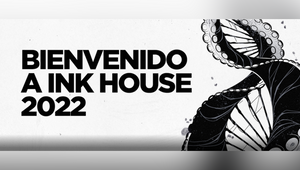
5 Minutes with… Francisco Samper

When Francisco Samper co-founded SSP3, alongside Jose Miguel Sokoloff and Humberto Polar, his vision was to build an agency that put creativity at its heart – and one which didn’t take its identity from the predominant American model of the time. And in the space of 20 years (the agency was founded in 1996), it has become a trailblazer and standard bearer for Colombian creativity. The agency’s much-awarded work for the country’s Ministry of Defence is an exemplar of Latin American innovation as well as an oft-cited case study of creativity leading to substantial social change.
And in that two decades, Francisco has also seen the international perception of Latin America change. His home country, Colombia, is very much a darling of the international ad community; Uruguay is frequently mentioned as an unsung creative wellspring; Brazil is seen as a powerhouse with problems; Mexico is a giant which may not have yet reached its creative potential but the recent tensions regarding a certain wall have inspired a slew of brilliantly defiant and politically bold ads. And the rest of the world? Well, the rest of the world seemingly can’t get enough of Latin creative talent.
There’s a lot going on – but what’s clear is that the days of sycophantically copying the models of North America are long gone.
These days, Francisco is President of MullenLowe Group Latin America and Co-Chairman and CEO MullenLowe SSP3, which allows him to understand the region both as a whole and as a collection of diverse cultures, economies and societies.
LBB’s Laura Swinton caught up with Francisco following his in depth LATIN TALKS series of films to find out more…
LBB> The LATIN TALKS series is super in depth and detailed – why did you decide to create such a series?
FS> In 2016, Wayne Arnold, MullenLowe Profero’s Global CEO, created a short series that would help demystify certain perceptions of the Asian countries where foreign business people had invested resources and, in turn, offered helpful insights for conducting business in Asia. We thought that our region could also benefit from a similar initiative, because I’ve observed that in the rest of the world the reality of Latin America is quite blurred; I thought it would be interesting to help paint a more realistic picture of how we are.
Utilising an interview format gave me the opportunity to feature some of the wonderful talent we have in the region as guests. Both creatives and management, including the brilliant young people that are thriving in our network, were able to share their thinking and their ideas. Additionally, we were able to interview important leaders like Luis Alberto Moreno, President of the Inter-American Development Bank, who was generous enough to share his knowledge of our region.
LBB> What do you think the rest of the world’s ad industry fails to understand about the markets of Latin America?
FS> Because Latin America is fundamentally conformed by a vast territory of countries whose majority are Spanish speaking (with the exception of Brazil, of course), there’s a tendency to think there are very minor differences among them; that they’re all practically the same. Although there are many factors that unite these countries, there are also many factors that are significantly different: political, historical, cultural, and social factors affect the way we live, the way we do business and thus, the way we do brand communications.
LBB> Throughout your career, have you seen perceptions of Latin American advertising change at a global level within the industry?
FS> Definitely yes. Today the level and quality of Latin advertising and advertisers is recognised the world over. Europe, Asia and the US are actually full of Latin professionals who occupy leadership roles and are responsible for some of the most famous campaigns in the world.
Sometimes I think it's like the Latin American boom of the ‘60s and ‘70s, from which so many of our iconic writers, like García Márquez, Cortázar, Fuentes, Vargas Llosa, etc. flourished and while they became internationally known, they influenced literature in a way can still see today.
I think that for the past 15-20 years we’ve been living a Latin America advertising boom. Today, the level and quality of Latin advertising and advertisers is recognised globally.
LBB> How did you first get involved with advertising? Was it an industry you sought out or was it a bit more accidental?
FS> It was in no way a random decision; it was totally premeditated. Ever since I was finishing high school, I became really interested in advertising; I poked around to find out what the faculty was like and decided that was what I wanted to do with my professional life.
At that time, there were probably only two universities in Colombia with advertising faculties and their reputation in the industry was not the best. So, when I asked for advice from the father of my best friend who owned an agency and was one of the forefathers of the Colombian advertising industry, he advised me to study abroad. He told me something that changed my future that day: “Advertising is not learned studying, but working.” I challenged him to give me a job, which he did; I started working in the art department in January 1979, as I had just turned 18, and even before I began my first semester in the university.
LBB> The decision to co-found SSP3 in 1996 was, indeed, a fateful one! It is now one of the stars of not just Latin American advertising, but the international advertising industry! And, of course, the work with the Ministry of Defence has proven just how profound an impact creativity can have. What initially motivated you to set up the agency with José Miguel Sokoloff and Humberto Polar? And looking back, how do you feel about all that the agency has achieved?
FS> Before starting the agency I had worked for 17 years, 11 of which I had been at McCann-Erickson, by far the leading and biggest agency in the market, and also, if not the first, one of the top two in creative performance (the CCO was Humberto Polar and the other agency was Leo Burnett, where José Miguel was CCO). I was CEO for Colombia when I left to start SSP3.
The reason was simple: I wanted to have an agency much less like the American agencies of the time and more like the British or Brazilian agencies, that really put creativity at the centre of everything and prevailed over all else. Honestly, the intention was not necessarily to own an agency, but to have a better agency. The country was going through a rough economic recession, advertising investment was in a crisis and I thought it was the moment to bet that creativity would take brands forward, instead of doing it based on air time, which demanded fat chequebooks and was the American agency model: ‘drill, drill and keep on drilling until people got the message’.
Humberto and José Miguel were the two creative directors with the best reputation in the market and I was the CEO of the leading agency. The combination had to work, among other things, because we were betting on the work the three of us could do as a team. That’s why, quite ambitiously, we dared to write, at the very beginning of that agency we were starting, the vision of what we aimed to be: one of the most recognised companies in the world for creativity.
It sounded almost naïve, coming from Colombia, but as you suggest in your question, 20 years later we’ve achieved all the awards and global accolades that one can aspire to in this trade, in creativity (Cannes’ Titanium and D&AD’s Black Pencil) as well as in strategic planning (the GP in IPA, APG and Jay Chiat the same year), and in effectiveness (among the six most effective agencies in the world for three consecutive years, according to the Effie Index). Plus we have been named as the International Agency of the Year in the A1 List of Ad Age in 2013; one of the most innovative companies in Latin America according to Fast Company; or having been amongst the innovators in advertising according to The Internationalist. That’s why today, more than awards, what drives me the most is that our work helps make life a little better for people.
The work we’ve developed for Colombia’s Ministry of Defense and the demobilisation of the guerrilla program has no doubt been the project that has brought me the most satisfaction in life. That campaign has taught me that through the immense power of communication you can achieve almost anything, and I want to put that at the service of good causes that may impact society.
LBB> And do you think advertising is seen as an attractive career choice for young people in Latin America?
FS> Definitely.
When you see the amount of young people who attend advertising conferences and festivals, or the groups of students requesting visits to agencies, or how they comment and share ads on social media, you get a sense that our industry still has a huge appeal among the youth. An industry that changed the social glamour of the ‘60s for an intellectual glamour at the service of good causes.
But, we must recognise that our youth is not that much different from the youth of other continents and that the world is constantly changing along with their interests. On one hand, technology has become as important as the ideas themselves and therefore, consulting companies are also incredibly appealing workplaces for today’s youth. While many now have the ability to create content, they are coming so close to the industry, although not necessarily in a formal manner.
On the other hand, I think that, even given our creative, relaxed and informal nature, agencies in Latin America have to continue to make huge efforts to adapt to the needs and attitudes of young talent. We need to make sure we are an industry where young talent feels like they can make an impact and give meaning to their life, where they feel they contribute to a better world, which is a prevalent trend among the youth today.
LBB> Everywhere I travel for work, I seem to meet Latin Americans (especially Colombians and Brazilians) who are leading agencies. Singapore, China, US and, yes, even London… What is it about the cultures in Latin America that makes it such a hotbed for creative talent?
FS> Well, that’s precisely one of the subjects that we cover in LATIN TALKS. Some say it’s our unique passion; others say we’re hard workers and are used to working long hours, while others talk about resourcefulness in a context of few economic resources. And others attribute it to our mixed historical and cultural backgrounds. I think that, as Latin Americans, we have a unique combination of all these factors that makes the way we approach problem solving and innovation very different and appealing to other cultures. Today, there’s a boom of Latin creative talent not only within advertising, but within the arts, cinema, literature, music, and fashion.
LBB> On the flip side, how does the international appetite for Latin American creative talent impact the industry in the region? Is it seen as a brain drain or does it ultimately spread the word about Latin American talent and attract more interest in the region?
FS> Hernán Ponce precisely touches on that issue in LATIN TALKS and I agree with what he said. There is no doubt that the great appeal of our talent abroad benefits and increases the value of our industry in the region. But it’s making us ‘lose’ our talent to other markets, instead of attracting clients to hire our agencies in this region. That’s what should be happening.
Of course, with the popularity of Latin creative talent greater than ever, you always ask yourself, with this massive brain drain we’re experiencing, who’s going to mentor and teach the new generations? But the truth is that new and better talent is continuously emerging. It’s like for the last 20 years the inferiority complex was dropped and Latin Americans today feel not only competent, but comfortable competing on the world stage. And the young, emerging talent already have that attitude.
FS> When doing business in these markets, it is important to understand local nuances, whether they are cultural, social, economic, legal, or political.
Understanding local sensibilities is crucial when you want to create a cohesive environment to do business in our region. While you may discuss matters over a long lunch with drinks in Mexico, in Chile that may not be well received, and in Colombia it’s better to discuss business over a very early breakfast.
If you’re planning to run the same campaign across the region and shoot one video, you should know that some countries like Ecuador and Venezuela have laws that promote local production. This will affect your advertising budget and your whole regional strategy.
When you plan a business or marketing strategy for Latin America, you cannot assume that it will apply equally to Spanish speaking Latin America and Brazil. While we may share the same continent, our love for music, and of food, are two completely different cultures. Adapting your strategies will go well beyond just language adjustment.
FS> I would say without a doubt, Uruguay – although small, it’s always had enormous creative strength – Peru, Ecuador, Costa Rica, Panama, and Puerto Rico are countries we have to follow. Mexico is a sleeping lion that’s waking up.
LBB> I also wanted to mention – and I don’t know if you are aware of this – but the Irish Advertising association (IAPI) is trying to build the country’s reputation in both Europe and internationally. They have told me specifically that Colombia is the country they have admired and that they want to learn from. How does it make you feel to know that the country is inspiring other local advertising markets?
FS> Imagine how proud it makes us feel. Over 20 years ago, from McCann Colombia, we led several of the regional campaigns for Coca-Cola, which was far from expected. But now, it’s a fact that the peace process has many countries looking at us, like Congo, where some of our campaigns have been implemented, even with our counsel, to aid on The Invisible Children project.
I was not aware of what you mentioned about Ireland, but don’t forget that the peace agreement with the IRA was extensively studied by Colombia and maybe that coincidence, the fact that both countries have suffered a very serious internal armed conflict – which the Irish overcame very successfully, as we hope to do – have brought us closer in knowledge and perception in spite of huge geographical distance. We will be delighted to contribute whatever may be useful to them.
LBB> If anything characterises Latin American advertising – or at least the stuff we see at global award shows and in international publications – it’s the sense of innovation; using inventive means to get a bigger reach by creating a real story. The work that tends to penetrate globally seems to be the stuff that isn’t about traditional advertising channels and ad spends. Do you think that’s a fair characterisation (if so, why is that?), or is it just the nature of what global ad award juries are rewarding?
FS> No. It’s obvious that today there exists an awareness that the ad industry’s creativity can be put at the service of much more ambitious purposes than just advertising. For example, as I said before, making people’s lives easier. Today almost anyone can find an easier or better way of doing something through technology. That’s how apps emerge. And brands, far from being foreign to this, they need to add usefulness.
So, there’s no doubt that the impact of the ‘advertising for good’ that is done in our region certainly breaks all boundaries, because it’s true, it’s inspiring, and it’s also, in most cases, quite effective. But I think there is another element that also characterises Latin American advertising and it’s the power of our storytelling, also a subject we touched on in the LATIN TALKS series. Storytelling is at the heart of our culture, from our great writers, to our ‘novelas’. That innate talent has been naturally incorporated into our advertising and our innovation, where Argentines are the most renowned for their stories.
LBB> In the process of making the series, did anything surprise you?
FS> I think that we went in with the idea that when we asked our guests if they thought of Latin America as one region, or of their sub-region (Andean, South Cone, Central America, etc.) as one region, the majority would agree that we are one region and only highlight our minor differences.
It really was eye-opening to have a consensus amongst all our interviewees – most of them important entrepreneurs – in that they don’t see ours as one unified and unique region, except for the language commonality. Our economic realities and interests may differ significantly, but, at the same time, we believe that we can work together as a single region, as we have been doing increasingly. I think this is one of the most important insights that the series brings, not only for businesses and advertisers from other regions, but also for our own. If you are a business in Mexico looking to expand to the South Cone of Latin America, or if you are a Chilean company thinking of their ad strategy for the Peruvian market, our advice is to understand and work around the differences and not go in thinking it’s all the same because we all speak Spanish.









